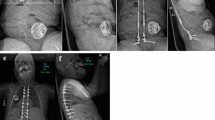Abstract
Study Design
Retrospective case analysis.
Objectives
Evaluate the cost difference between magnetically controlled growing rod (MCGR) and traditional growing rod (TGR) surgeries at initial implantation and determine the recipient of cost savings.
Summary of Background Data
Treatment of early-onset scoliosis is challenging and costly, with growing rods (GRs) becoming a standard treatment. Although both effectively control deformity, TGR requires repeat surgical lengthening and MCGR does not. Previous cost analyses have suggested that MCGR results in lower overall cost after 3 years because of the elimination of repeat surgeries; however, the benefactor of these savings is unclear.
Methods
All patients who underwent initial GR implantation from May 2011 to January 2016 at a tertiary care children’s hospital were included (37 cases: 16 MCGR and 21 TGR; 4 TGR to MCGR conversions). Financial information was analyzed including insurance provider, and amount billed to and reimbursed from payer. Charges at the time of implantation were divided into categories (surgery time, room/board, anesthesia, implant cost, lab, radiology, therapy, medications, neuromonitoring, operating room materials, and recovery room). Variables were compared using t-tests to determine differences overall and per category.
Results
The average overall charge for MCGR implantation was 1.5 times greater than TGR implementation (p = .04). Average charges were statistically similar across all categories, except implant costs, which were significantly higher for MCGR (MCGR: $31,621 vs. TGR: $8,966, p < .0001). The average percentage reimbursement of total charges were similar between surgeries (MCGR 43% vs. TGR 46%, p = .26).
Conclusions
MCGR implantation has a significantly higher charge than TGR, secondary to the higher expense of MCGR implants. Despite this, total institutional reimbursement is similar between the two procedures. Although MCGRs have been shown to be “cost effective” after 3 years, our findings suggest health care institutions bear the cost of this new technology while payers gain the long-term financial benefit.
Level of Evidence
Level III, economic analysis.
Similar content being viewed by others
References
Akbarnia BA, Breakwell LM, Marks DS, et al. Dual growing rod technique followed for three to eleven years until final fusion: the effect of frequency of lengthening. Spine (Phila Pa 1976) 2008;33: 984–90.
Akbarnia BA, Pawelek JB, Cheung KM, et al. Traditional growing rods versus magnetically controlled growing rods for the surgical treatment of early-onset scoliosis: a case-matched 2-year study. Spine Deform 2014;2:493–7.
Rushton PRP, Siddique I, Crawford R, et al. Magnetically controlled growing rods in the treatment of early-onset scoliosis: a note of caution. Bone Joint J 2017;99:708–13.
Charroin C, Abelin-Genevois K, Cunin V, et al. Direct costs associated with the management of progressive early onset scoliosis: estimations based on gold standard technique or with magnetically controlled growing rods. Orthop Traumatol Surg Res 2014; 100: 469–74.
Polly Jr DW, Ackerman SJ, Schneider K, et al. Cost analysis of magnetically controlled growing rods compared with traditional growing rods for early-onset scoliosis in the US : an integrated health care delivery system perspective. Clinicoecon Outcomes Res 2016;8: 457–65.
Rolton D, Richards J, Nnadi C. Magnetic controlled growth rods versus conventional growing rod systems in the treatment of early onset scoliosis: a cost comparison. Eur Spine J 2015;24:1457–61.
Su AW, Milbrandt TA, Larson AN. Magnetic expansion control system achieves cost savings compared to traditional growth rods: an economic analysis model. Spine (Phila Pa 1976) 2015;40:1851–6.
Wong CKH, Cheung JPY, Cheung PWH, et al. Traditional growing rod versus magnetically controlled growing rod for treatment of early onset scoliosis: cost analysis from implantation till skeletal maturity. J Orthop Surg (Hong Kong) 2017;25. 2309499017705022.
Teoh KH, Winson DM, James SH, et al. Do magnetic growing rods have lower complication rates compared with conventional growing rods? Spine J 2016;16(suppl):S40–4.
Doany ME, Olgun ZD, Kinikli GI, et al. Health-related quality of life in early-onset scoliosis patients treated surgically: EOSQ scores in traditional growing rod versus magnetically controlled growing rods. Spine (Phila Pa 1976) 2018;43:148–53.
Author information
Authors and Affiliations
Corresponding author
Additional information
Author disclosures: MEO (none), EMM (none), ALM (none).
Source of funding: None.
IRB approval: Ethics approval for the study was obtained through institutional IRB.
Rights and permissions
About this article
Cite this article
Oetgen, M.E., McNulty, E.M. & Matthews, A.L. Cost-Effectiveness of Magnetically Controlled Growing Rods: Who Really Benefits?. Spine Deform 7, 501–504 (2019). https://doi.org/10.1016/j.jspd.2018.09.066
Received:
Revised:
Accepted:
Published:
Issue Date:
DOI: https://doi.org/10.1016/j.jspd.2018.09.066



